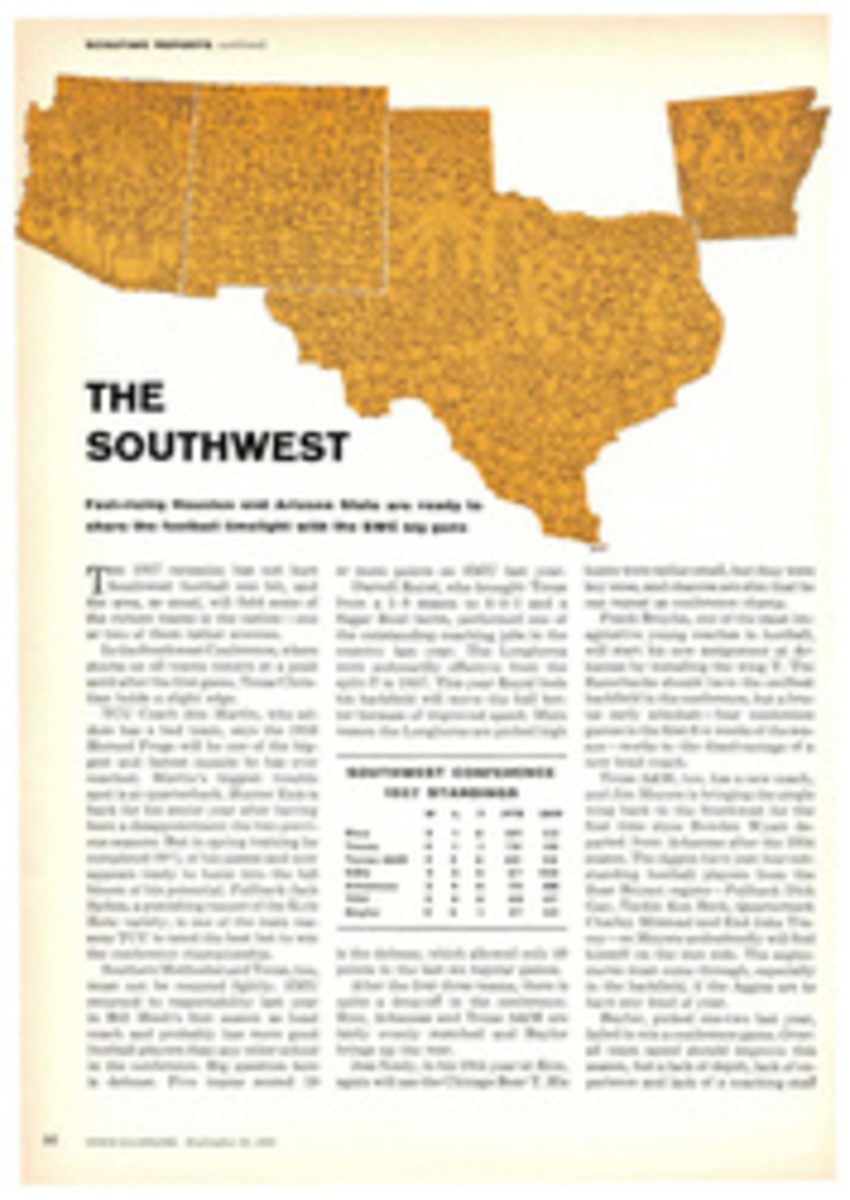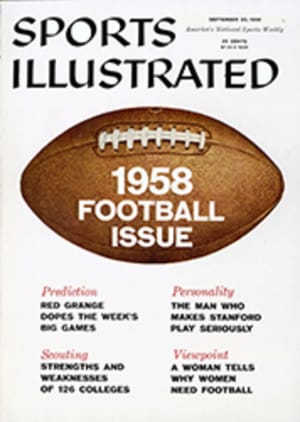
RETURN OF CHARLIE COE
The 1955 National Open, as most golfers remember, was played over the Lake Course of the Olympic Country Club in San Francisco, the same course which last week was the scene of the 1958 National Amateur Championship. The '55 Open was one of the most genuinely dramatic events in golf history, and its effect on any witness was, apparently, permanent. The green ghosts of Ben Hogan and Jack Fleck still walk the dipping fairways beneath the tall pine and eucalyptus and the cypress, and as you look down one hole after another and see the familiar contours, the whole sequence of the stirring playoff takes form in your mind and you can practically see Hogan and Fleck hit their shots and watch the ball in flight.
While the recent Amateur is not likely to leave such lasting impressions on the minds of the spectators, it was, nevertheless, a fine and enjoyable championship. It was played during a streak of very unusual California weather—six straight balmy days—and it brought together in the final the two men who had consistently played the best golf during the week: the veteran Charlie Coe, a 34-year-old oil broker from Oklahoma City, and Tommy Aaron, a 21-year-old Georgian who had qualified for the tournament for the first time. Dour and terribly determined every step of the way, Coe won the final 5 and 4 and so regained the championship he had won at Oak Hill in Rochester back in 1949.
It is a tremendous feat for an athlete to recapture a national title after an interval of almost a decade, and in Charlie Coe's case, returning to the top must taste very sweet indeed. When he captured the Amateur in 1949, Coe looked so thoroughly impressive that many sound observers predicted that this would be only the first of the many championships the spare, laconic Oklahoman would collect. Over the next few seasons Coe won several important sectional tourneys and was a finalist in the 1951 British Amateur, but he never quite realized his first promise. Moreover, his game then began to slip a discernible notch and after a while he was considered just another capable player, tough on his good days but very erratic and beatable on others. In the 1957 Masters he hit his low point: it took him 86 blows to get around. Right after this he decided that he would have to tear his swing apart and rebuild it then and there if he hoped to play the kind of golf he felt he still had in him. Over the last 15 months he has worked like the very devil rehearsing and refining his new swing—a much shorter and compacter one than his first wood-notes wild—and his perfectionistic application has accomplished wonders. He was low amateur in the Open last June and now here he is once again the National Amateur Champion.
As the crowd gathered at the Olympic Country Club, of course, the subject of most discussion was not Charlie Coe but Harvie Ward. Returning to the Amateur after sitting out a year's suspension, Ward, the 1955 and 1956 champion, was out to see if he could make it three in a row, something that neither Bob Jones nor Walter Travis nor Jerry Travers nor anyone, for that matter, had been able to achieve. Harvie is now a resident of San Francisco and he naturally drew the largest galleries, all of them pulling hard for this exceedingly amiable fellow who may well be the finest amateur the world has seen since the mid-1930s. In the Americas Cup matches, which directly preceded the Amateur, Harvie had played spotty golf, and round by round the spectators at the championship were wondering when he would strike his old, familiar form. He never really did. Thanks to his marvelous work on and around the greens, he got as far as the fifth round. There he went down before Ward Wettlaufer, a roly-poly powerhouse who was 2 up at the turn and played par golf in to close out the match on the 16th.
With Harvie gone, it was a different tournament—both artistically and financially, as they say. A rather eye-opening format, however, presented itself for that Thursday afternoon: four collegians were spotted in each of the four quarter-final matches—Deane Beman of Maryland (who had defeated Johnny Dawson); Wettlaufer from Hamilton; Dick Foote of UCLA (who had eliminated Don Cherry and Don Bisplinghoff); and Tommy Aaron of the University of Florida (who had eliminated Phil Rogers and Dick Chapman). Beman, an energetic little golfing machine who hits an average of 400 practice balls daily, played Coe and gave him a very rough match. Charlie won it 1 up, gaining the vital advantage with a birdie 4 on the 603-yard 16th, where the fairway swings from right to left in the arc of a crescent. Wettlaufer also lost 1 down, bowing to Roger McManus of Cincinnati, a very poised competitor albeit an authentic weekend golfer. The other two collegians won over two Walker Cup players, Foote beating Dr. Bud Taylor 4 and 3 and Aaron racing away from Charley Kocsis 7 and 5. In the Kocsis match Aaron was out in 33, hitting the ball high or low as he wanted to, fading it, drawing it, and in short playing every shot in the book with confidence and dispatch.
It was at about this time that numerous tournament camp followers began to claim—oh, they'll do it every time—that they had spotted Tommy Aaron at the very beginning of the week and had predicted without reservation that this boy had the stuff to go all the way. Aaron is a big, broad-shouldered, soft-spoken fellow who played T quarterback for his high school in Gainesville, Ga. but decided to concentrate on golf. His father is the professional at the Gainesville Club, but this year the course was flooded under in the construction of Buford Dam, and while a new course is being built Mr. Aaron is selling insurance and his son has been driving the 40 miles to the course in Athens to get his practice in. In the semifinal, where Coe defeated McManus 3 and 2, Aaron continued to play wonderful golf. Around in 67 in the morning, a real score on Olympic, he was even par for the nine holes he needed in the afternoon to end his match with Dick Foote, 10 and 9. This spree placed Aaron 2 under par for the 117 holes he had played.
And then the final. In a curious way, it pivoted on the 21st hole, a difficult 220-yarder where the green lies at the foot of a long and deep slope. Coming to the 21st, Coe was 2 up, the margin he had held at the end of the morning 18. Aaron had not been able to hold his earlier form, and Coe, who had been worried and uneasy during his semifinal match because he couldn't get into a strong and comfortable position at address and didn't know exactly what adjustment to make, had got it back (as he later related) on the 11th tee by raising his hands at address. This minute change got his action in gear again and he had begun to hit the ball much more freely, and more accurately. On the short 21st, though, it looked like he might be tiring. He did everything wrong: pulled his tee shot into a bunker, left it there, then punched it over the green and finally overhit his chip coming back before conceding the hole to Aaron. On the heels of this haggard sequence, with his lead cut to a single hole and the gallery wondering if the 21st presaged further troubles for him, Coe proceeded to win the match and the championship. Playing flawless golf—and hitting his long irons especially well—Charlie ripped off five holes in a row when Aaron suddenly lost his concentration and produced a mixture of loose and poorly conceived shots. The young man pulled himself together on the 27th, and from there on to the end hit one lovely shot after another, but so did Coe. It was all over on the 32nd when Charlie holed a 27-footer across the green for his birdie. Then with the long tournament and that long climb back to the top behind him at last, he took off his cap and smiled. It was the first smile Charlie had allowed himself all week.
PHOTO
HY PESKIN
CHARLIE COE, CLIMAXING GREAT SURGE OF GOLF IN FINAL, RUNS DOWN 27-FOOT PUTT TO WIN MATCH ON 32ND GREEN
TWO PHOTOS
HY PESKIN
WINNER COE ACCEPTS TROPHY WHILE RUNNER-UP TOM AARON MUSTERS MANFUL GRIN

